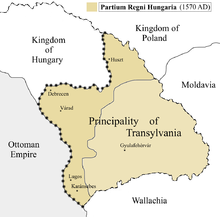| Revision as of 05:47, 2 April 2012 editDobitocilor (talk | contribs)153 edits Voivodeship of Transylvania← Previous edit | Revision as of 05:59, 2 April 2012 edit undoKoertefa (talk | contribs)Extended confirmed users5,237 edits Undid revision 485112266 by Dobitocilor (talk) Sorry, the Voivodeship of Transylvania was not a country, moreover, it did not cover the area of the East. Hung. KingdomNext edit → | ||
| Line 19: | Line 19: | ||
| |year_leader2 = 1540-1570 | |year_leader2 = 1540-1570 | ||
| |event = | |event = | ||
| |p1 = |
|p1 = Kingdom of Hungary in the Middle Ages | ||
| |flag_p1 = Flag of Hungary (15th century, rectangular).svg | |flag_p1 = Flag of Hungary (15th century, rectangular).svg | ||
| |s1 = Principality of Transylvania (1570–1711) | |s1 = Principality of Transylvania (1570–1711) | ||
Revision as of 05:59, 2 April 2012
| Eastern Kingdom of HungaryKeleti Magyar Királyság (hu) | |||||||||
|---|---|---|---|---|---|---|---|---|---|
| 1538–1570 | |||||||||
 Coat of arms
Coat of arms
| |||||||||
 Eastern Hungarian Kingdom in 1550 Eastern Hungarian Kingdom in 1550 | |||||||||
| Capital | Buda (1526/38-1541) Gyulafehérvár (1541-1570) | ||||||||
| Common languages | Latin (in administration, science and politics); Hungarian | ||||||||
| Religion | Roman Catholicism, Calvinism, Lutheranism | ||||||||
| Government | Kingdom Vassal state of the Ottoman Empire | ||||||||
| King of Hungary | |||||||||
| • 1526/38-1540 | John I | ||||||||
| • 1540-1570 | John II | ||||||||
| History | |||||||||
| • Established | 1538 | ||||||||
| • Treaty of Várad | 1538 | ||||||||
| • Ottoman occupation of Buda | 1541 | ||||||||
| • Disestablished | 1570 | ||||||||
| |||||||||
The Eastern Hungarian Kingdom was the name of the area under the rule of King John I of Hungary. John I of Hungary was the former voivode of Transylvania and the wealthiest and the most powerful landlord after Mohács, secured the eastern part of the kingdom with the help of the Ottomans. There were several attempts to unite the two Hungarian kingdoms under Habsburg rule, but the Turks prevented this by drawing the Eastern Hungarian Kingdom under their protection. On 29 February 1528, the sultan assented to an alliance with Zapolya and gave written assurance of his support.
In 1526, after the Battle of Mohács, the Kingdom of Hungary was overrun by the Ottomans, but effectively split into 3 parts in 1541 when the Ottomans captured Buda. Initially, the country was ruled by two crowned kings (between 1526 and 1538), however this problem was temporary solved when the Habsburgs got a foothold in the north and west, Royal Hungary, with the new capital Pressburg, according to the secret agreement of Nagyvárad in 1538.
John II Sigismund's reign
| This section needs expansion. You can help by adding to it. (October 2011) |
In 1540, when Zápolya died, his son John II Sigismund Zápolya was crowned by the Hungarian estates.
From 1541 or 1542, the house of Zápolya also controlled the region that after 1571 became known as Partium.
In 1568, the freedom of religion was formally recognized and guarantied by John II Sigismund in the Edict of Torda. This religious tolerance and diversity had a lasting impact.

In 1570, John II Sigismund Zápolya, son of John I Zápolya renounced his claim as King of Hungary (1540-1570) in favour of Maximilian II of Habsburg, who also claimed the title since 1563. Instead John II Sigismund Zápolya remained Prince of Transylvania between 1570 and 1571.
Treaty of Speyer
In 1571, by the Treaty of Speyer (Spires), John II Sigismund, John I's son, abdicated as king of Hungary, and a new dukedom was invented for him: "Joannes, serenissimi olim Joannis regis Hungariae, Dalmatiae, Croatiae etc. filius, Dei gratia princeps Transsylvaniae ac partium regni Hungariae" (imperial prince), from which derives the name Partium.
This treaty, like the earlier Grosswardein accord, endorsed the principle of a united Hungary. Partium and Transylvania were entrusted to John II Sigismund, but under the title of imperial prince. As mentioned above, the Zápolya held Partium before, but the treaty allowed them to do this without fear that the Habsburgs would contest the house of Zápolya's lordship. In a sense, Zápolya traded title for territory.
Eastern Hungarian Kingdom ceased to exist, and Transylvania became an autonomous state, under the suzerainty of the Ottoman Empire, Principality of Transylvania, where native princes, who paid the Turks tribute, ruled with considerable autonomy and where Austrian and Turkish influences vied for supremacy for nearly two centuries. All rulings after 1570 as King of Hungary refer to the territory known as "Royal Hungary", and as Prince refer to the "Principality of Transylvania". Also, the Ottomans annexed central and southern Hungary. Habsburg Austria controlled Royal Hungary, which consisted of northern part (mostly present day Slovakia and northeast Hungary) and counties along the Austrian border and some of northwestern Croatia.
See also
References
- Béla Köpeczi, History of Transylvania, Volume 2, Social Science Monographs, 2001, p. 593
- Iván Boldizsár, NHQ; the new Hungarian quarterly, Volume 22, Issue 1, Lapkiadó Pub. House, 1981, p. 64
- ^ Robert John Weston Evans, T. V. Thomas, Crown, Church and estates: Central European politics in the sixteenth and seventeenth centuries, Macmillan, 1991, p. 80-81
- ^ István Keul, Early modern religious communities in East-Central Europe: ethnic diversity, denominational plurality, and corporative politics in the principality of Transylvania (1526-1691), BRILL, 2009, p. 40
- Oksana Buranbaeva, Vanja Mladineo, Culture and Customs of Hungary, ABC-CLIO, 2011, p. 44
- ^ A Country Study: Hungary. Federal Research Division, Library of Congress. Retrieved 2009-01-11.
